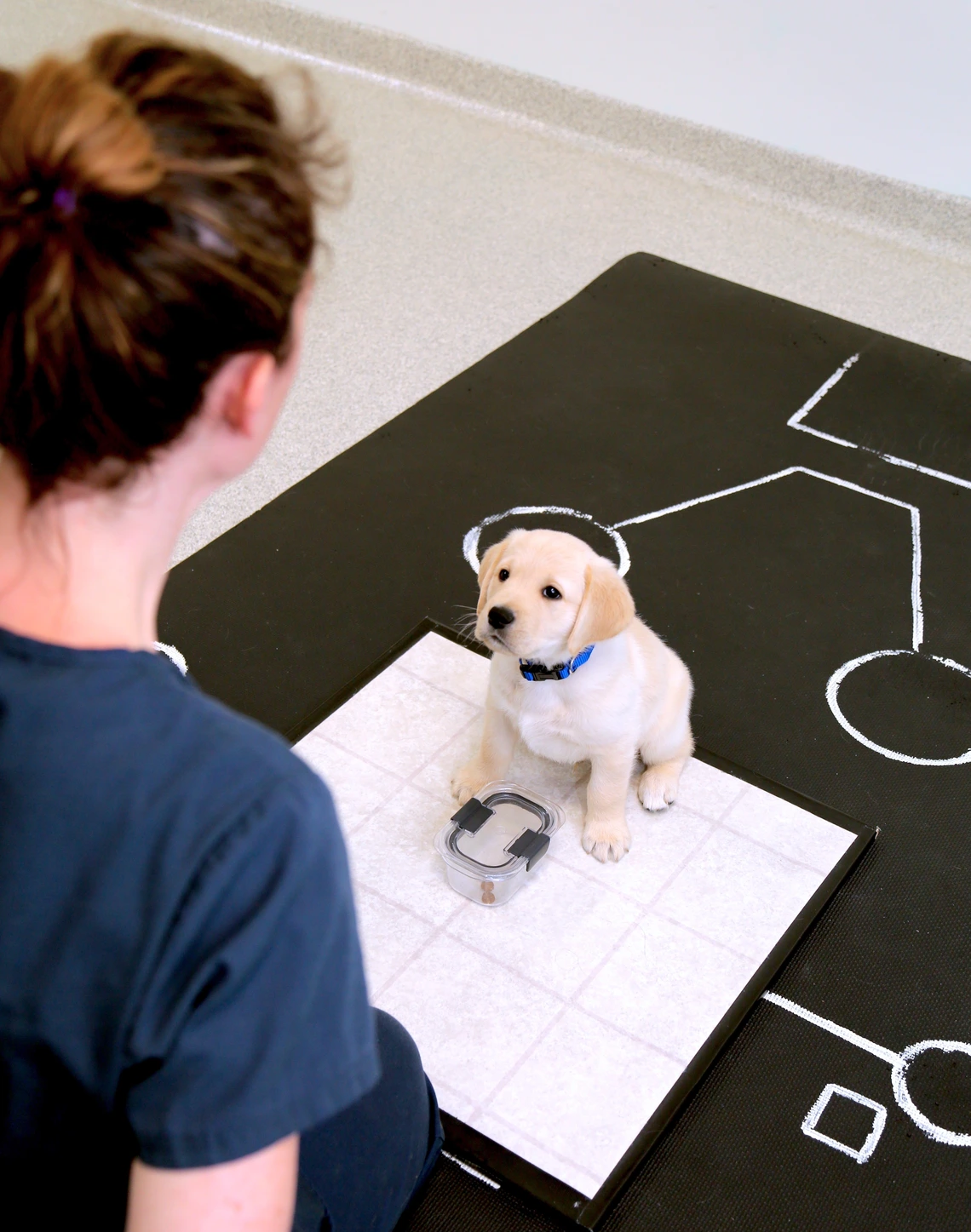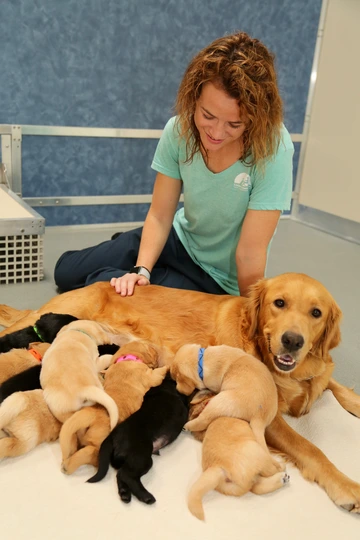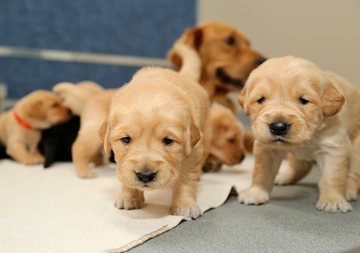New Human-Animal Bond Research Begins
Human-Animal Interaction is an interdisciplinary area brimming with research opportunities that can benefit both animal and human health.

Human-Animal Interaction is an interdisciplinary area brimming with research opportunities that can benefit both animal and human health. Discoveries in this area have immense potential to shift our understanding of mental and physical health and provide vital data points for future healthcare decisions. Our Human-Animal Interaction research team embodies Arizona’s explorative and compassionate ethos as they design and carry out groundbreaking advancements at the intersection of the biological and psychological sciences.
A Passion for Exploration
Exploration and a desire to discover why animals impact the well-being of owners has been a driving force of Maggie O’Haire’s research since graduate school. Maggie’s persistent work has not only made her renowned in her field of research focused on Human-Animal Interaction and the human-animal bond but also has allowed her to become a passionate leader and mentor. She has accumulated more than 60 peer-reviewed publications with over 3,000 citations, given more than 230 national and international presentations, and received 16 national and international awards. Under her leadership, the University of Arizona will retain the largest Human-Animal Interaction faculty group in the world. Her research lab was recently awarded a five-year National Institutes of Health (NIH) grant to study how service animals impact mental health outcomes of military veterans with PTSD (Posttraumatic Stress Disorder). When asked about her passions in research, Dr. O’Haire shared,
“Throughout my career, I have had a fascination with how humans interact with animals. My specialty is being a psychology researcher who establishes evidence-based outcomes for our interactions with animals. I look at a variety of populations, from companion animals in the home, all the way to specially trained service or assistance animals who complete complex tasks to help mitigate disabilities. At every juncture, I am trying to use the best, most rigorous assessment. My passion is building strong science behind the outcomes for humans.”
At CVM, Dr. O’Haire will apply this mindset alongside her colleague, Dr. MacLean, as they work to make discoveries that will shed light on human and animal health and cognition.
Specializing in animal behavior and cognition, Dr. Evan MacLean is the founder and director of the Arizona Canine Cognition Center. He earned his Ph.D. in Evolutionary Anthropology from Duke University and has experience studying animal problem-solving and cognitive processes in species as varied as pigeons, chimpanzees, bonobos, lemurs, and dogs. His recent research focus is studying canine cognition and exploring how dogs think and understand the world around them. He believes the processes through which animals are selected, bred, and trained for roles can be improved through research. He said,
“Dogs were the first domesticated animal tens of thousands of years ago. I got really interested in questions about how this partnership has arisen. I want to understand what is going on in the mind on the other side of this partnership. My specialty is in dog behavioral biology, which is an umbrella term which captures aspects of dog temperament, behavior, and cognition. One of the central themes in my research is trying to understand sources of variation, because dogs are one of the most variable species on the planet. You have all these animals that are of the same species but are so different behaviorally. For example, only about half the dogs that begin professional training programs to be service dogs complete it. What is it that sets half of them apart? I am most excited about continuing to work on trying to understand the origins of that variation.”
Between Dr. O’Haire’s examination of the human side of Human-Animal Interaction and Dr. MacLean’s exploration of the animal side, the team is enthusiastically engaged in their interdisciplinary research endeavors here at Arizona. Of their partnership, Dr. MacLean shared, “Dr. O’Haire and I are a good team because I come from a focus on dogs and studying dog behavioral biology. Dr. O’Haire comes from a perspective of thinking about humans and psychological science. Together, we are both are thinking about this intersection of humans and other animals.”
Compelling Connections

Given the notable bond between humans and animals, our research team plans to unleash their curiosity and explore how health is impacted as a result. Our researchers’ teamwork will prove to be key to their combined efforts. When asked to discuss their collaboration, Dr. O’Haire described the strengths of developing research teams with expertise regarding both animal behavior and human health. She noted that “historically, those two questions have been answered in isolation by independent researchers and independent groups. By collaborating, we can look at things that are happening simultaneously and look at whether there's synchronicity in human-animal biological rhythms and patterns, in their behavior, and in their psychological outcomes. Being in a place where we have that interdisciplinary or transdisciplinary approach is so exciting and will open opportunities to answer questions that were previously unable to be answered. This approach will accelerate scientific advances and impact.”
Connecting human and animal research in this way allows our team to collaboratively discover new answers about the countless ways humans and animals have of influencing one another’s health. This pioneering effort leads to research opportunities in areas deeply in need of data, and our research team’s combined efforts will lead to more robust answers to our most pressing questions.
Pioneering Human-Animal Interaction Research

Researchers have only scratched the surface of investigating Human-Animal Interaction. Our interdisciplinary approach aims to delve into the connections people have anecdotally discussed for years and offer helpful data points for decision-making. In the context of their current study, our researchers examine how service animals impact the lives of veterans with PSTD, a topic that has long been discussed but has historically lacked robust science to validate the ideas. Advances in research can lead to better care for veterans and facilitate easier access to the service animals that can provide the best care.
Dr. MacLean intends to uncover why certain dogs succeed in service animal work, while some are better suited for a more leisurely life. He believes a greater understanding of which animals should be selected will lead to better human decisions regarding service animals, including greater access, better training, and more successful canine candidates. He stated,
“If we are looking at a particular behavior, we try to understand how much of that variation is genetic in nature. How much is environmental? We even have studies right now where we are looking at the first three weeks of a dog's life, looking at the puppies’ interaction with the mother. And we find that the types of interaction that puppies have with their mother in the first three weeks of life is associated with individual differences in behavior and cognition at 18 months. These are things that we need to know and understand, because if we want to set dogs up for success in the world, we can do two things. We can do our best to breed healthy dogs and then we can try to create the environments that they need to be successful.”
On the human side, Dr. O’Haire seeks to understand how animals can impact human health. She said, “I believe our collaboration will allow us to find out how setting up the dogs to be successful can lead to the human’s success as well.” She noted that pairing a human with the right service animal can make a significant difference in the success of the treatment. These efforts can lead to greater benefits for the humans and animals involved. Their current work will shed light on how service animals impact veterans with PTSD by looking at multiple metrics. She shared,
“Currently, Evan and I have a grant from the National Institutes of Health for a five-year longitudinal, randomized clinical trial looking at the effects of service dogs for military veterans with posttraumatic stress disorder in their families. Our goal is to look at this from both sides, human and animal. For the humans, we are looking at impacts on psychological, social, and emotional functioning as well as sleep and stress hormone physiology. For the dogs, we are looking at stress hormone physiology and behavioral profiles, including where they are at baseline, how they pair with their human, and where they end up. We are examining the humans alongside the dog side holistically.”
Essential human-animal research can inform areas such as clinician knowledge, medical referrals, insurance coverage, funding for service animals and their training, and more. Our team is investigating to provide a voice for recipients of service dogs by supplying useful data to the people and organizations that ultimately make healthcare decisions that impact our larger society. Additionally, clinicians need evidence to make informed recommendations to patients and policymakers need evidence to create greater long-term governmental support. Studying this aspect of Human-Animal Interaction can supply the evidence and data that decision-makers need most. Dr. O’Haire shared,
"The research is important for many reasons, from wait times to funding to access to animal-assisted interventions. We need evidence so we can improve services for the human and for the dog. As with any treatment or medication, it is important to build and improve efficacy or efficiency over time. We owe it to the humans and the animals involved to answer these questions so that their experiences can be meaningful and helpful. We want to work on setting up the future for generations for success.”
Currently, many individuals who could potentially benefit from a service dog face multi-year waitlists. Our researchers are not satisfied with that outcome, and their determination and compassion inform their vision to better understand and facilitate these powerful interventions.
Looking Forward
With our experienced research team, CVM is prepared to make groundbreaking discoveries, to share scientific advances with community stakeholders, and to lead the world in Human-Animal Interaction research. When discussing her vision for CVM’s current study, Dr. O’Haire shared, “It's my hope and my vision to give a voice to service animals and their humans through science.”
CVM students have the inspiring opportunity to participate in this pioneering research before they graduate. Selective clinical research rotations are available in students’ third year of study as well as volunteer opportunities throughout their course of study. They gain experience in research and exposure to the exciting world of Human-Animal Interaction. Our VetCats will graduate with unique experiences and an eye toward how Human-Animal Interaction impacts the health and well-being of humans and animals.
